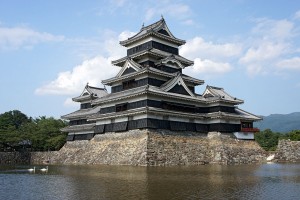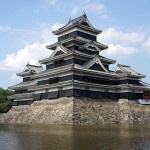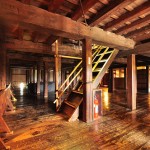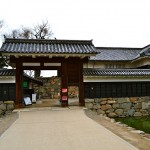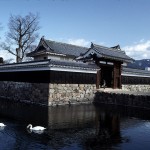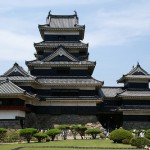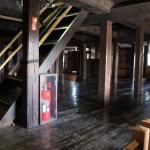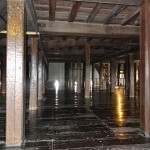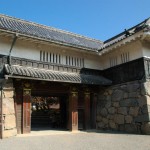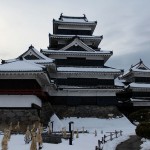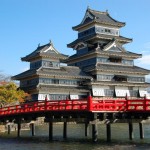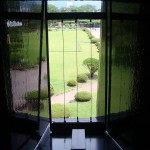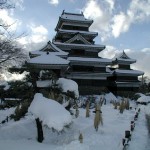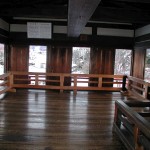Written by Soudip
January 21st 2016You Are Here
Home > Japan > Itsukushima Shrine Historical Facts and PicturesMatsumoto Castle Historical Facts and Pictures
Matsumoto Castle (Japanese: Matsumoto-jo) also called the Crow Castle (Japanese: Karasu-jo), is one of the oldest, iconic Japanese landmarks that was the headquarters of the Matsumoto domain. Being located in Matsumoto city, the castle is easily accessible from Tokyo by rail or road. The premier historic structure, constructed on a plain and not amid rivers or a hilltop, has preserved its black and white exterior as well as the original wooden interiors.
History
The Matsumoto Castle was founded during the Sengoku Period when Shimadachi Sadanaga belonging to the Ogasawara Samurai clan constructed a fort in 1504. During the mid-16th century, the fort was ruled by the Takeda clan, and few years later, it came under the authority of Tokugawa Ieyasu. The rule of Matsumoto castle was placed under Ishikawa Norimasa when Ieyasu was transferred to Kanto. Ishikawa along with his son Yasunaga constructed several parts of the castle including the Watari Tower, the small tower, and the keep. It is believed that the construction of the entire castle including the residence, gates, moat, baileys, Tsukimi Yagura, and the castle sub-floors were completed in 1593-94.
Since the foundation of the Matsumoto Domain by the Tokugawa shogunate, the castle was reigned over by 23 Matsumoto lords representing different daimyo families. It remained the stronghold of the Matsumoto Domain for around 300 years until the feudal system was abolished during the Meiji Restoration. It was often called the Karasu-jo since its black and white roofs and walls resemble the spreading wings of a bird.
Architectural Features
The Keep or Main Tower
It is the most important feature of the castle and can be entered by passing through a minor keep known as Inui Kotenshu (situated towards the northwest). Even though the minor donjon appears to be structurally independent, it is connected with the main tower through a roofed passageway (Watari-yagura). The first and second floors are supported by 10 round pillars while the upper floors are held up by 12 pillars.
- First floor: This floor, covering an area of 42 feet x 36 feet, has very tiny holes. Initially, the floor was separated by internal walls into different rooms that were used for storing food, projectiles, gunpowder, and an array of weaponry. Since firearms were used to ward off attacks on the castle, the tower features 55 square holes (teppozama) and 62 long loopholes (yazama) from which small cannon, matchlock muskets, and arrows could be fired at the enemy.
- Second Floor: It is divided into 8 rooms that served as the living quarters of the samurai during emergencies. This floor is now home to a gun museum, called the Teppo Gura, which exhibits a collection of armor and weapons belonging a local citizen, Akahane Michishige.
- Third Floor: It is known as the “dark floor” as it does not have any windows and remains hidden from the outside. It was utilized for stocking and supplying foods and equipment to the floors above.
- Fourth Floor: Designed in a different way, this floor has a higher ceiling, more windows, and a lesser number of pillars. It is believed that this spacious floor housed the chamber of the daimyo.
- Fifth Floor: It was used by the garrison leaders to hold conversations and discussions on coordinating defenses and deciding tactics.
- Sixth Floor: The top floor is at a height of 22.1 m above the entrance and offers wonderful views.
- Matsumoto Castle
- Inside of Matsumoto Castle
- Matsumoto Castle Entrance
- Matsumoto Castle Gate Moat
- Matsumoto Castle Images
- Matsumoto Castle Inside
- Matsumoto Castle Interior
- Matsumoto Castle Kuromon Black Gate
- Matsumoto Castle Pictures
- Matsumoto Castle Seen from the Bridge
- Matsumoto Castle Window
- Matsumoto Castle Winter
- Tsukimi Yagura
Tsukimi-yagura
This is the Moon Viewing Wing of the castle. It is joined to the main donjon on the west while its eastern, southern, and northern ends have openings. Unlike the other parts of the castle, the Moon Viewing Wing was not built for defense; rather it was for relaxation and enjoyment.
Category
JapanWritten by Soudip
January 21st 2016


